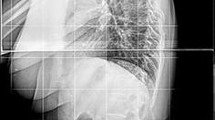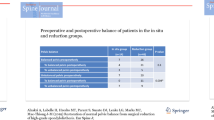Abstract
Aim
The objective of this study was to evaluate the safety and efficacy of a novel technique of formal reduction and circumferential fusion for pediatric high-grade spondylolisthesis (HGS).
Purpose
The safety and efficacy of formal reduction for high-grade spondylolisthesis (HGS) has never been thoroughly examined. This study reports the outcomes of 29 children with HGS who underwent a procedure of gradual reduction and circumferential fusion.
Methods
29 children (13 males, 16 females) were recruited between 2006 and 2010. Radiographic measurements (including % of slip, lumbosacral angle—LSA, pelvic incidence—PI, pelvic tilt—PT, sacral slope—SS, and proximal femoral angle—PFA) and quality of life assessment (SRS-22 questionnaire) were prospectively obtained at baseline and at the last post-operative follow-up (> 2 years post-op). Radiological measurements were used to classify patients according to the Spine Deformity Study Group (SDSG) classification.
Results
Mean baseline slip % was 69.9 ± 16.5%. There were 13 patients with a balanced pelvic (SDSG Type 4) and 16 with an unbalanced pelvis (SDSG Type 5 and 6). On average, a reduction of 45.5 ± 15.3% (range 20–86%) was achieved safely with no major complication. In particular, of the 29 patients, only 3 had a L5 radiculopathy postoperatively that was self-resolved at follow-up. From a radiological standpoint, we observed a mean improvement of LSA from 80.3 ± 17.9° to 91.7 ± 13.6°. We also observed a statistically significant improvement in global HRQOL, and in the function and body image domains.
Conclusion
This prospective study suggests that formal reduction of HGS followed by circumferential fusion is safe when using a standardized surgical technique based on gradual reduction. Performing this intervention could also help improve QOL in some patients.




Similar content being viewed by others
Data availability
Measurements and analysis done at the CHU Sainte-Justine are on a password protected server. Access may be arranged through application to the IRB.
References
Spondylolisthesis HM (1932) Surgery. Gyn Obs 54:371–377
Molinari RW, Bridwell KH, Lenke LG, Ungacta FF, Riew KD (1999) Complications in the surgical treatment of pediatric high-grade, isthmic dysplastic spondylolisthesis. A comparison of three surgical approaches. Spine. https://doi.org/10.1097/00007632-199908150-00012
Martiniani M, Lamartina C, Specchia N (2012) “In situ” fusion or reduction in high-grade high dysplastic developmental spondylolisthesis (HDSS). Eur Spine J. https://doi.org/10.1007/s00586-012-2230-2
He R, Tang GL, Chen K, Luo ZL, Shang X (2020) Fusion in situ versus reduction for spondylolisthesis treatment: grading the evidence through a meta-analysis. Biosci Rep. https://doi.org/10.1042/bsr20192888
Lamberg T, Remes V, Helenius I, Schlenzka D, Seitsalo S, Poussa M (2007) Uninstrumented in situ fusion for high-grade childhood and adolescent isthmic spondylolisthesis: long-term outcome. J Bone Joint Surg Am 89(3):512–518. https://doi.org/10.2106/jbjs.E.00545
Deckey DG, Kalish LA, Hedequist D et al (2019) Surgical treatment of developmental spondylolisthesis: contemporary series with a two-surgeon team. Spine Deform 7(2):275–285. https://doi.org/10.1016/j.jspd.2018.08.004
Joelson A, Diarbakerli E, Gerdhem P, Hedlund R, Wretenberg P, Frennered K (2019) Self-image and health-related quality of life three decades after fusion in situ for high-grade isthmic spondylolisthesis. Spine Deform 7(2):293–297. https://doi.org/10.1016/j.jspd.2018.08.012
Štulík J, Geri G, Barna M, Klézl Z (2022) High-grade high-dysplastic lumbosacral spondylolisthesis in children treated with complete reduction and single-level circumferential fusion: a prospective case series. Brain Spine 2:100871. https://doi.org/10.1016/j.bas.2022.100871
Koucheki R, Rocos B, Gandhi R, Lewis SJ, Lebel DE (2023) Surgical management of high-grade paediatric spondylolisthesis: meta-analysis and systematic review. Eur Spine J 32(2):436–446. https://doi.org/10.1007/s00586-022-07408-3
Fu KM, Smith JS, Polly DW Jr et al (2011) Morbidity and mortality in the surgical treatment of six hundred five pediatric patients with isthmic or dysplastic spondylolisthesis. Spine. https://doi.org/10.1097/BRS.0b013e3181cf3a1d
Sansur CA, Reames DL, Smith JS et al (2010) Morbidity and mortality in the surgical treatment of 10,242 adults with spondylolisthesis. J Neurosurg Spine 13(5):589–593. https://doi.org/10.3171/2010.5.SPINE09529
Nielsen E, Andras LM, Siddiqui AA et al (2020) 40% reoperation rate in adolescents with spondylolisthesis. Spine Deform 8(5):1059–1067. https://doi.org/10.1007/s43390-020-00121-5
Labelle H, Mac-Thiong JM, Roussouly P (2011) Spino-pelvic sagittal balance of spondylolisthesis: a review and classification. Eur Spine J. https://doi.org/10.1007/s00586-011-1932-1
Crawford CH 3rd, Larson AN, Gates M et al (2017) Current evidence regarding the treatment of pediatric lumbar spondylolisthesis: a report from the scoliosis research society evidence based medicine committee. Spine Deform 5(5):284–302. https://doi.org/10.1016/j.jspd.2017.03.011
Mac-Thiong JM, Hresko MT, Alzakri A et al (2019) Criteria for surgical reduction in high-grade lumbosacral spondylolisthesis based on quality of life measures. Eur Spine J 28(9):2060–2069. https://doi.org/10.1007/s00586-019-05954-x
Koller H, Mühlenkamp K, Hitzl W et al (2021) Surgical outcomes with anatomic reduction of high-grade spondylolisthesis revisited: an analysis of 101 patients. J Neurosurg Spine. https://doi.org/10.3171/2021.3.Spine202091
Rivollier M, Marlier B, Kleiber JC, Eap C, Litre CF (2020) Surgical treatment of high-grade spondylolisthesis: technique and results. J Orthop Nov-Dec 22:383–389. https://doi.org/10.1016/j.jor.2020.08.015
Shufflebarger HL, Geck MJ (2005) High-grade isthmic dysplastic spondylolisthesis: monosegmental surgical treatment. Spine. https://doi.org/10.1097/01.brs.0000155583.55856.f9
Morvan G, Mathieu P, Vuillemin V et al (2011) Standardized way for imaging of the sagittal spinal balance. Eur Spine J. https://doi.org/10.1007/s00586-011-1927-y
Pea R, Dansereau J, Caouette C, Cobetto N, Aubin CE (2018) Computer-assisted design and finite element simulation of braces for the treatment of adolescent idiopathic scoliosis using a coronal plane radiograph and surface topography. Clin Biomech (Bristol, Avon) 54:86–91. https://doi.org/10.1016/j.clinbiomech.2018.03.005
Aubin CE, Bellefleur C, Joncas J et al (2011) Reliability and accuracy analysis of a new semiautomatic radiographic measurement software in adult scoliosis. Spine. https://doi.org/10.1097/BRS.0b013e3181f0825a
Mac-Thiong JMLH (2016) Chapter 23 Developmental Spondylolisthesis. In: Steinmetz MPBE (ed) Benzel’s Spine Surgery. Elsevier, Netherland
Hresko MT, Labelle H, Roussouly P, Berthonnaud E (2007) Classification of high-grade spondylolistheses based on pelvic version and spine balance: possible rationale for reduction. Spine. https://doi.org/10.1097/BRS.0b013e31814b2cee
Petraco DM, Spivak JM, Cappadona JG, Kummer FJ, Neuwirth MG (1996) An anatomic evaluation of L5 nerve stretch in spondylolisthesis reduction. Spine. https://doi.org/10.1097/00007632-199605150-00002
Mac-Thiong JM, Hresko MT, Alzakri A et al (2023) A surgical treatment algorithm for restoring pelvic balance and health-related quality of life in high-grade lumbosacral spondylolisthesis: prospective multicenter cohort of 61 young patients. Clin Spine Surg. https://doi.org/10.1097/bsd.0000000000001499
Lorio C, Koucheki R, Strantzas S et al (2023) Utility of intraoperative neurophysiological monitoring in detecting motor and sensory nerve injuries in pediatric high-grade spondylolisthesis. Spine J. https://doi.org/10.1016/j.spinee.2023.08.002
Lak AM, Abunimer AM, Devi S et al (2020) Reduction versus in situ fusion for adult high-grade spondylolisthesis: a systematic review and meta-analysis. World Neurosurg 138:512-520.e2. https://doi.org/10.1016/j.wneu.2020.03.030
Bago J, Perez-Grueso FJ, Les E, Hernandez P, Pellise F (2009) Minimal important differences of the SRS-22 patient questionnaire following surgical treatment of idiopathic scoliosis. Eur Spine J 18(12):1898–1904. https://doi.org/10.1007/s00586-009-1066-x
Funding
Chair in Movement Sciences, CHU Sainte-Justine and University of Montréal.
Author information
Authors and Affiliations
Contributions
Antoine Dionne: Data acquisition, Analysis interpretation of data, Drafting the work, Critical revision, Final approval, Agree to be accountable for all aspects of the work. Jean-Marc Mac-Thiong: Design of the work, Data acquisition, Analysis interpretation of data, Critical revision, Supervision, Final approval, Agree to be accountable for all aspects of the work. Stefan Parent: Design of the work, Data acquisition, Critical revision, Final approval, Agree to be accountable for all aspects of the work. Jesse Shen: Data acquisition, Drafting the work, Critical revision, Final approval, Agree to be accountable for all aspects of the work. Julie Joncas: Data acquisition, Drafting the work, Critical revision, Final approval, Agree to be accountable for all aspects of the work. Soraya Barchi: Data acquisition, Analysis interpretation of data, Drafting the work, Critical revision, Supervision, Final approval, Agree to be accountable for all aspects of the work. Hubert Labelle: Design of the work, Analysis interpretation of data, Drafting the work, Critical revision, Supervision, Final approval, Agree to be accountable for all aspects of the work.
Corresponding author
Ethics declarations
Conflict of interest
AD has received a scholarship from the Medtronic Research Chair in Spinal Trauma at Université de Montréal. JMMT is chairholder of the Medtronic research chair in spinal trauma at Université de Montréal, owns stocks and is a board member in Spinologics, and has received a scholarship and research grants from the Fonds de recherche du Québec—Santé, an investigator-initiated research grant from Medline Industries, educational grants from Medtronic and Depuy-Synthes, as well as research grants from the U.S. Department of Defense—Congressionally directed medical research programs, Craig H. Neilsen Foundation, from Social Sciences and Humanities Research Council, Canadian Institutes of Health Research, Natural Sciences and Engineering Research Council, Praxis Spinal Cord Institute, Abbvie, Asahi Kasei Pharma and Vertex Pharmaceutical. SP has received outside the submitted work: royalties from EOS imaging, he is Co-founder of the company Spinologics Inc., he received consultancy fees from K2M, Medtronic and DePuy Synthes Spine, he received grants from DePuy Synthes Spine, Canadian Institutes of Health Research, Pediatric Orthopaedic Society of North America, Scoliosis Research Society, Medtronic, EOS imaging, Canadian Foundation for Innovation, Setting Scoliosis Straight Foundation, Natural Sciences and Engineering Council of Canada, Fonds de recherche Québec—Santé, grants and Orthopaedic Research and Education Foundation, he received fellowship support from DePuy Synthes and Medtronic, he is the holder of the Academic Chair in Pediatric Spinal Deformities of CHU Ste-Justine, he is member of speaker bureau of Orthopaediatrics. JS has received financial interests from Statera Medical, research grant from Scoliosis Research Society and research support from Centre de Recherche du Centre Hospitalier de l'Université de Montréal. JJ, and SB declare that they have no conflict of interest. HL is the co-founder of the company Spinologics Inc.
Ethical approval
All procedures performed in studies involving human participants were in accordance with the ethical standards of the institutional and/or national research committee and with the 1964 Helsinki Declaration and its later amendments or comparable ethical standards. The study was approved by the ethics Committee of the CHU Sainte-Justine.
Consent to participate
All research participants or their legal guardians provided written consent to be a part of the database and have the data collected be used in ongoing research on scoliosis.
Consent for publication
We obtained consent from the responsible authorities to submit this scientific work.
IRB approval
Institutional Review Board approval was obtained for this study from CHU Sainte-Justine IRB.
Additional information
Publisher's Note
Springer Nature remains neutral with regard to jurisdictional claims in published maps and institutional affiliations.
Supplementary Information
Below is the link to the electronic supplementary material.
Rights and permissions
Springer Nature or its licensor (e.g. a society or other partner) holds exclusive rights to this article under a publishing agreement with the author(s) or other rightsholder(s); author self-archiving of the accepted manuscript version of this article is solely governed by the terms of such publishing agreement and applicable law.
About this article
Cite this article
Dionne, A., Mac-Thiong, JM., Parent, S. et al. Clinical and radiological outcomes of gradual reduction and circumferential fusion of high-grade spondylolisthesis in adolescents: a prospective cohort study of 29 young patients. Spine Deform (2024). https://doi.org/10.1007/s43390-024-00884-1
Received:
Accepted:
Published:
DOI: https://doi.org/10.1007/s43390-024-00884-1




